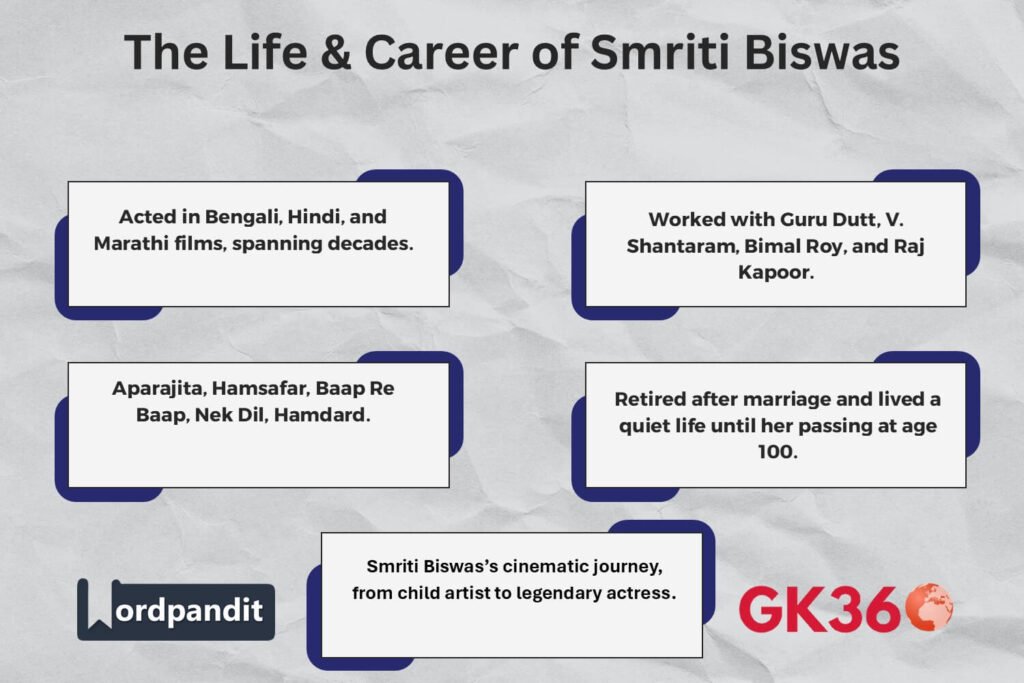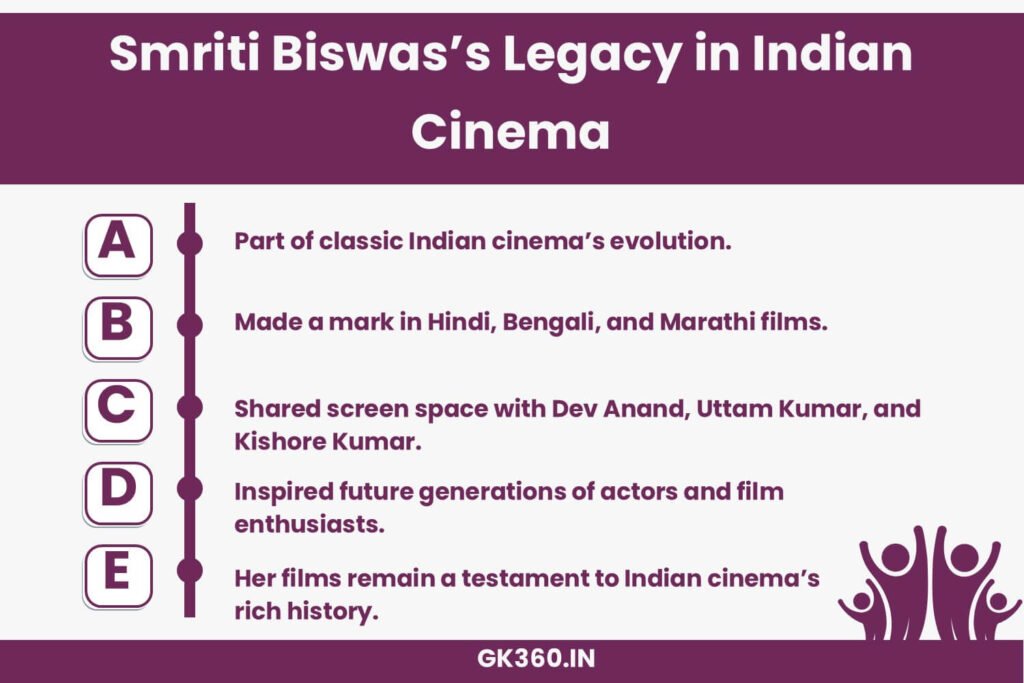Smriti Biswas: A Legendary Actress Who Defined an Era
Early Life and Career Beginnings
Born Smritirekha Biswas into a Christian family, she embarked on her cinematic journey as a child artist in the Bengali movie “Sandhya” (1930). With her natural screen presence and talent, she quickly became a recognized face in Indian cinema.

Table of Contents
- Early Life and Career Beginnings
- Rise to Fame and Cinematic Contributions
- Personal Life and Retirement
- Legacy and Influence on Indian Cinema
- FAQs About Smriti Biswas
- Conclusion
Rise to Fame and Cinematic Contributions
Over the decades, Smriti Biswas made significant contributions to the film industries of Bengal, Maharashtra, and Bollywood. She collaborated with some of the most renowned directors, including Guru Dutt, V. Shantaram, Mrinal Sen, Bimal Roy, B.R. Chopra, and Raj Kapoor. Her versatility allowed her to portray a wide range of roles, making her an unforgettable presence on the silver screen.
Notable Films
- Nek Dil
- Aparajita
- Hamsafar
- Hamdard
- Chitgaon
- Baap Re Baap
Her performances alongside legendary actors such as Dev Anand, Kishore Kumar, Uttam Kumar, and Balraj Sahni further cemented her place in cinematic history.
Personal Life and Retirement
After her marriage to filmmaker S.D. Narang, Smriti Biswas decided to step away from the film industry. Her last screen appearance was in the 1960 film “Model Girl”. Following Narang’s passing in 1986, she moved to Nashik, where she spent the remainder of her life.
Life in Nashik and Later Years
Despite her iconic status, Smriti Biswas faced financial hardships after her husband’s death. She lived a quiet life, away from the limelight, until her passing in 2024.
Legacy and Influence on Indian Cinema
Smriti Biswas’s contributions to Indian cinema remain invaluable. Her ability to bring characters to life across different languages and genres showcased her immense talent and dedication to her craft. Her journey provides insight into the evolution of Indian cinema, and her films continue to be studied and appreciated by cinephiles and film scholars alike.
Her extensive body of work in Hindi, Bengali, and Marathi films helped shape the golden era of Indian cinema, leaving an enduring influence on generations of filmmakers and actors.

FAQs About Smriti Biswas
- What was Smriti Biswas’s most famous film? She starred in several notable films, but “Aparajita” and “Baap Re Baap” are among her most well-remembered performances.
- When did Smriti Biswas start her acting career? She began her acting career as a child artist in the 1930 Bengali film “Sandhya.”
- Why did Smriti Biswas retire from acting? She retired in 1960 after marrying filmmaker S.D. Narang.
- Where did Smriti Biswas spend her final years? After her husband’s passing, she lived in Nashik, where she passed away in 2024.
- What impact did Smriti Biswas have on Indian cinema? Her extensive body of work across Hindi, Bengali, and Marathi films helped shape the golden era of Indian cinema, making her a respected and celebrated figure in film history.
Conclusion
The passing of Smriti Biswas marks the end of an era in Indian cinema. Her dedication to the craft, versatility in acting, and contribution to multiple film industries make her a true legend. As we remember her, we celebrate the timeless performances that continue to inspire future generations.
Key Takeaways Table
| Aspect | Details |
|---|---|
| Full Name | Smritirekha Biswas |
| Film Industries | Hindi, Bengali, Marathi |
| Debut Film | Sandhya (1930, Bengali) |
| Notable Films | Aparajita, Baap Re Baap, Hamdard, Nek Dil |
| Major Collaborators | Guru Dutt, V. Shantaram, Raj Kapoor, Bimal Roy |
| Reason for Retirement | Married filmmaker S.D. Narang in 1960 |
| Final Years | Lived in Nashik after her husband’s passing in 1986 |
| Age at Passing | 100 (July 3, 2024) |
Related terms
- Smriti Biswas Actress Biography
- Smriti Biswas Hindi Cinema Legend
- Smriti Biswas Bengali Film Industry
- Smriti Biswas Best Movies
- Golden Era of Indian Cinema
- Smriti Biswas and Guru Dutt Films
- Veteran Actresses of Indian Cinema
- Bollywood Legends 1950s
- Classic Indian Film Actresses
- Smriti Biswas Nashik Life





